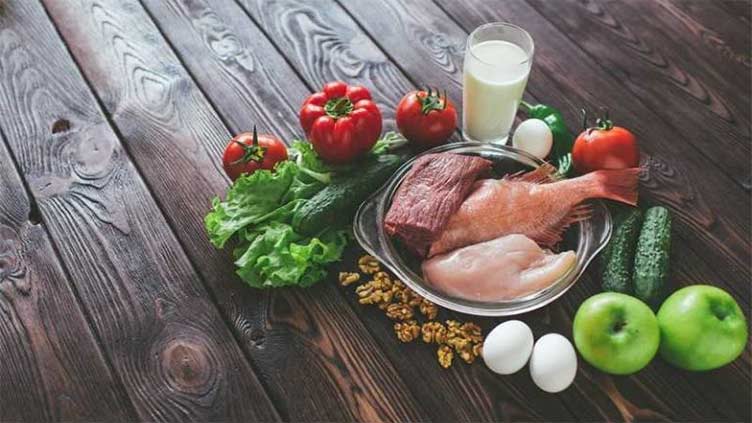How to follow a cutting diet for weight loss

How to follow a cutting diet for weight loss
ISLAMABAD, (Online) - A cutting diet involves calculating your calorie, protein, fat, and carb needs to reduce body fat and maintain muscle mass. It should be paired with weightlifting and is usually followed before an athletic event or competition.
Cutting is an increasingly popular workout technique.
It’s a fat loss phase that bodybuilders and fitness enthusiasts use to get as lean as possible.
Typically started a few months before a major workout regimen, it involves a weight loss diet that’s meant to maintain as much muscle as possible.
This article explains how to follow a cutting diet for weight loss.
What is a cutting diet?
A cutting diet is usually used by bodybuilders and fitness enthusiasts to cut body fat while maintaining muscle mass.
The key distinctions with other weight loss diets are that a cutting diet is catered to each individual, tends to be higher in protein and carbs, and should be accompanied by weightlifting.
Lifting weights regularly is important because it promotes muscle growth, helping combat muscle loss when you start cutting calories.
A cutting diet lasts 2–4 months, depending on how lean you are before dieting, and is normally timed around bodybuilding competitions, athletic events, or occasions like holidays.
A cutting diet aims to get you as lean as possible while maintaining muscle mass. It’s typically done for 2–4 months leading up to a bodybuilding competition or other event.
How to do a cutting diet
A cutting diet is tailored to each individual and requires you to determine your nutritional needs.
Calculate your calorie intake
Fat loss occurs when you consistently eat fewer calories than you burn.
The number of calories you should eat per day to lose weight depends on your weight, height, lifestyle, sex, and exercise levels.
You can estimate the number of calories that you need to consume per day to maintain your weight using an online calorie calculator. To lose 1 pound (lb), or 0.45 kilograms (kg), per week, simply subtract 500 calories from this number.
Alternatively, a registered dietitian can help determine how many calories you should consume per day, depending on your goals.
A slow, even rate of weight loss — such as 1 lb (0.45 kg) or 0.5%–1% of your body weight per week — is best for a cutting diet.
Although a larger calorie deficit may help you lose weight faster, it can increase your risk of losing muscle, which is not ideal for this diet.
Determine your protein intake
Maintaining adequate protein intake is important on a cutting diet.
Numerous studies have found that high protein intake can aid fat loss by boosting your metabolism, reducing your appetite, and preserving lean muscle mass.
If you’re on a cutting diet, you need to eat more protein than if you’re merely trying to maintain weight or build muscle mass. That’s because you’re getting fewer calories but exercising routinely, which increases your protein needs.
Most studies suggest that 1–1.4 grams (g) of protein per lb of body weight (2.2–3.0 g per kg) is sufficient for conserving muscle mass on a cutting diet.
For example, a 155-lb (70-kg) person should eat 150–210 g of protein per day.
Determine your fat intake
Fat plays a key role in hormone production, which makes it crucial for a cutting diet.
While it’s common to reduce fat intake on a cutting diet, not eating enough can affect the production of hormones like testosterone and IGF-1, which help preserve muscle mass.
For example, studies demonstrate that reducing fat intake lowers testosterone levels by a modest but significant amount.
However, some older evidence suggests that a drop in testosterone levels does not always lead to muscle loss — as long as you eat enough protein and carbs.
Experts suggest that, on this diet, 20%–30% of your calories should come from fat.
One gram of fat contains 9 calories, so anyone on a 2,000-calorie regimen should eat 44–67 g of fat per day on a cutting diet.
If you do intense exercise, the lower end of that fat range may be best because it allows for higher carb intake.
Determine your carb intake
Carbs play a key role in preserving muscle mass while on a cutting diet.
Because your body prefers to use carbs for energy instead of protein, eating an adequate number of carbs may combat muscle loss.
Additionally, carbs can help fuel your performance during workouts.
On a cutting diet, carbs should comprise the remaining calories after you subtract protein and fat, or around 0.9–2.2 g/lb (2–5 g/kg) of body weight.
Protein and carbs both provide 4 calories per g, while fat stands at 9 calories per g. After subtracting your protein and fat needs from your total calorie intake, divide the remaining number by 4, which should tell you how many carbs you can eat per day.
For example, a 155-lb (70-kg) person on a 2,000-calorie cutting diet may eat 150 g of protein and 60 g of fat. The remaining 860 calories (215 g) can be taken up by carbs.
To plan a cutting diet, you should calculate your calorie, protein, fat, and carb needs based on your weight and lifestyle factors.
Does meal timing matter?
Meal timing is a strategy used for muscle growth, fat loss, and performance.
Although it may benefit competitive athletes, it isn’t as important for fat loss.
For example, many studies note that endurance athletes can boost their recovery by timing their meals and carb intake around exercise.
That said, this isn’t necessary for the cutting diet.
Instead, you should focus on eating whole foods and getting sufficient calories, protein, carbs, and fat throughout the day.
If you’re hungry frequently, some older studies suggest that a high calorie breakfast may keep you fuller later in the day.


